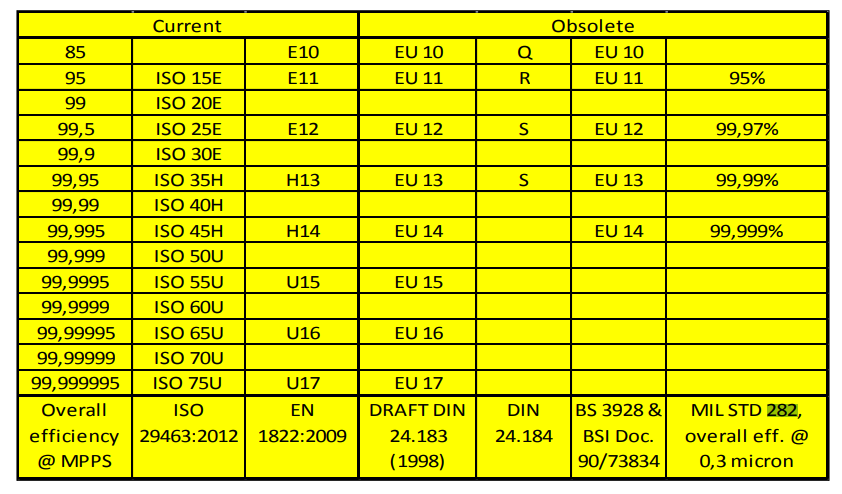There's a EU EN standard 1822 for air filters that has seen several iterations. The pre-2009 versions of EN 1822 (which seems to have come out in 1998) were pretty confusing as they allowed poorer filters to be labeled as H or HEPA; e.g. a "HEPA 12" filter would filter 99.9% of particulates, but this is strictly inferior the US HEPA which filters 99.97% of particles of 0.3 um (assuming Wikipedia is correct about this). The 2009 revision of EN 1822 somewhat fixed this as anything below 99.95% is now called "EPA" instead, so the "HEPA 12" from EN 1822:1998 is now "EPA 12" under EN 1822:2009.
I'm still not sure if the two standard are really comparable though. I don't know what the particulate size is for EN 1822, nor am I sure what is the difference between "integral value" and "local value" for the emissions under EN 1822. The latter in particular is somewhat worrisome because it carries a footnote that allows manufacturers to change this by agreement with the purchaser, which I suspect some may turn into a sort of click-wrap agreement.
So is HEPA 13 under EN 1822:2009 (integral value ≥ 99.95%, local value ≥ 99.75%) approximately the same as US HEPA or does one need to move to H14 for that (integral value ≥ 99.995, local value ≥ 99,975)?
Or maybe there's something else that I'm missing because I've found a comparison that puts the Mil Std 292 numbers below those from EN 1822, so I guess there's a difference in testing methodology that accounts for this. Does someone know the details to clarify?
This latter table surely refers to pre-2009 versions of EN 1822, as no year is stated anywhere in the document and has "H12" and so forth in it. A similar version but using the newer EN terminology can be found on the website of a different manufacturer, but oddly there's a E11 but H12 in there. These tables don't inspire much confidence because I'm not sure 292 is even the US Mil. Std. number for HEPA filters, (the 292 standard is about rockets). Different documents state it as Mil Std 282, which is indeed about fitlers for protective cloting... but otherwise the equivalence stated is about the same [H]EPA 12 being the same as the US HEPA of 99.97%.
Is this correct though, and if it is what in the testing method explains the difference?

